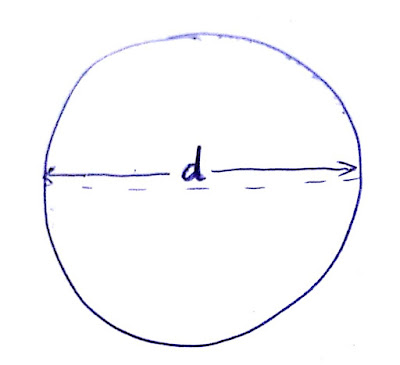Lecture - 8 ( pressure inside a liquid droplet, bubble and liquid jet )
Hey guys before going through this lecture, first of all you should clear your concepts of surface tension. That's why I recommend you to go through Lecture - 5 first.
The Cut section view of the liquid jet is shown in below diagram. The arrows shown across the length represent surface tension.
Pressure inside a liquid droplet
Here, we will calculate gauge pressure (Pgauge ). Gauge pressure is the pressure measured by considering that the atmospheric pressure is zero. We will have a detailed discussion on all types of pressure in my upcoming lectures. Let me clear one thing that there is a difference between a water droplet and bubble. Water droplet is filled with water from inside and outside atmosphere is present whereas in bubble inside the liquid film also air is present and of course outside of liquid film of bubble air is present. Remember we are considering atmospheric pressure is zero. On The Water droplet two forces are acting one is constructive force and other is destructive force. Water droplet is formed with the equilibrium of both these forces. Pressure from inside of water droplet will try to break the droplet and that's why it it is called destructive force. This pressure will act upon some area. Other force is surface tension force which will occur due to cohesive bonds. Surface tension force will always act along length or we can say perimeter of body. Tendency of surface tension force is to minimise the area of water droplet as it is acting along the perimeter. Now the situation is that surface tension force is trying to minimise the area of water droplet by acting along its perimeter whereas pressure of water present inside the water droplet will try to resist it. As surface tension force increase pressure inside the water droplet increases due to which droplet brust off. Therefore at some point both surface tension force and pressure will attain equal and opposite value and at that moment formation of water droplet is there. In this whole process surface tension force is our constructive force where is pressure is destructive force.
From this whole process we also get to know that why water droplet is in the form of sphere. The reason is as we know surface tension tries to minimise the area because of cohesive bonds of water therefore only sphere is the only shape among all shapes which has minimum area that's why droplet will have a shape of sphere. Quality of sphere is that it has smallest surface area of all surfaces that enclose a given volume, and it encloses the largest volume among all closed surfaces with a given surface area.
Let us consider a sphere or water droplet of diameter 'd' is shown in below figure.
In below figure the Cut section diagram of this water droplet is shown. This is a free body diagram on which forces are shown. The arrows shown by green colour are representing surface tension force which is acting on the perimeter of sphere and the arrow shown by black colour is representing the pressure acting on body.
σ = Fs / L
'σ' represents surface tension
'Fs' surface tension force
'L' represents length or perimeter over which surface tension is acting
P = Fp/A
'P' represents pressure
'Fp' represents force due to pressure
'A' represents area on which pressure force is acting
For equilibrium Fp = Fs
Therefore P*A = σ*L
area of sphere (A) = (πd^2)/4
Perimeter of sphere (L) = π*d
∴ P = (4σ)/d
As we discussed in starting of lecture that this pressure is gauge pressure.
Pressure inside a bubble
Bubble is a thin layer of fluid, inside which air is present and outside obviously atmosphere is there. Let us consider outer surface of layer is having diameter 'D' and inner surface of layer is having diameter 'Di'. As we know bubble is formed with very thin film of fluid therefore 'Di' and 'D' is almost equal.
Di ≈ D = d
In the below figure the cut section of a bubble is shown. The arrows in the green colour shows the surface tension force on perimeter of outer surface and the arrows in the black colour shows the surface tension force on perimeter of inner surface.
In case of bubble surface tension force will act on perimeter of outer and inner surface which tries to minimise the area which is restricted by the pressure of air present inside the bubble.
'Fp' represent pressure force
'Fs' represent surface tension force
As pressure is acting on inside area of bubble so,
Fp = Pressure (P) * area of inner surface (A)
Fp = (P*π*Di^2)/4
As surface tension is acting on perimeter of outer and inner surface so,
Fs = surface tension*( perimeter of outer surface + perimeter of inner surface)
Fs = σ*(πDi + πD)
Fs = σ*(2πd)
Bubble will form when both the forces are in equilibrium.
Therefore Fp = Fs
P*(π/4)*d^2 = σ*2*π*d ; because Di ≈ D = d
P = 8σ/d
Remember this 'P' is gauge pressure.
Pressure in a liquid jet
In the figure below a liquid Jet is shown whose diameter is 'd' and length is 'L'
Fp = P*area of rectangle
Fp = P*L*D
Fs = σ*2*L
Here also Fp = Fs
P*L*D = σ*2*L
P = 2σ/D
Remember this 'P' is gauge pressure
P*L*D = σ*2*L
P = 2σ/D
Remember this 'P' is gauge pressure
Check out my YouTube channel Mechanical education hub








Wow,nicely explained..
ReplyDeleteSuperb....
ReplyDeleteBut why not Fs=σ*2*(l+r)
ReplyDeleteits a lot helpful
ReplyDeletethanks a lot
Beautifully explained ☺️
ReplyDelete